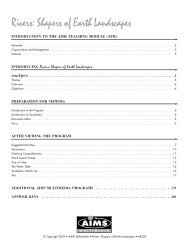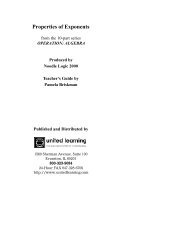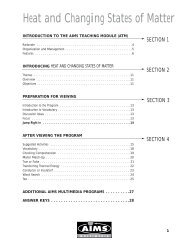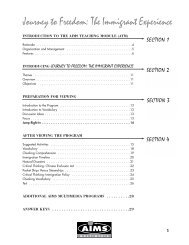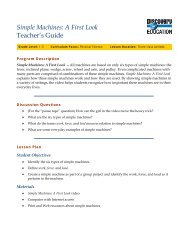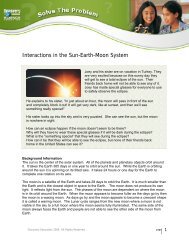Discussion Questions – Yoshi, The Lantern Maker
Discussion Questions – Yoshi, The Lantern Maker
Discussion Questions – Yoshi, The Lantern Maker
- No tags were found...
You also want an ePaper? Increase the reach of your titles
YUMPU automatically turns print PDFs into web optimized ePapers that Google loves.
<strong>Discussion</strong> <strong>Questions</strong> <strong>–</strong> <strong>Yoshi</strong>, <strong>The</strong> <strong>Lantern</strong> <strong>Maker</strong>1. What was the name of the main characterin the story? (<strong>Yoshi</strong>)2. What did he do for a living? (He was alantern maker.)3. What did <strong>Yoshi</strong> do every morning? (Hewent to the great stone outcrop nearhis village and chipped off part of theoutcrop to make a lantern.)4. Was <strong>Yoshi</strong> a good lantern maker? Howdo you know? (Yes, because he wasknown throughout his country for hisbeautiful lanterns and they were foundat many Shinto shrines and many otherplaces.)5. What did <strong>Yoshi</strong> use to carry his toolsand chipped stone? (A wheelbarrow)6. What did <strong>Yoshi</strong> see at the rich merchant’shouse? (<strong>The</strong> beautiful pottery,furniture and artwork in the merchant’sbedroom)7. What did <strong>Yoshi</strong> wish for when he walkedhome from the merchant’s house?(That he had a home like the merchant’smansion)8. Who overheard <strong>Yoshi</strong>’s wish? Whatdid he do? (A kami. He granted thewish.)9. Why did <strong>Yoshi</strong> wish to be a prince?(So he could ride in a carriage and havea giant umbrella to shade him)10. Why did <strong>Yoshi</strong> want to be the sun?(Because it was more powerful thanthe prince)11. What did <strong>Yoshi</strong> do as the sun?(He sent sunrays to the earth to scorchplants and burn skin.)12. Why did <strong>Yoshi</strong> wish to be a cloud?(Because he thought it was morepowerful than the sun)13. What good and bad things did<strong>Yoshi</strong> do as a cloud? (He sentrain to the earth; he sent too muchrain, causing foods.)14. Why did <strong>Yoshi</strong> want to become arock? (Because he thought it wasmore powerful than a cloud)15. What made <strong>Yoshi</strong> the rock tremble?(<strong>The</strong> chisel and hammer of the personchipping rocks)16. What did <strong>Yoshi</strong> the rock wish to be?Why? (A human, because he thoughtthe human was more powerful)17. What does the old saying, “<strong>The</strong> grass isalways greener on the other side of thefence” mean? How does it apply to the<strong>Yoshi</strong>? (Answers will vary.)18. Is <strong>Yoshi</strong> a foolish person? Why or whynot? (Answers will vary.)19. How did <strong>Yoshi</strong> abuse his power? (Hecaused a drought as the sun and floodsas a cloud.)20. Have you ever wanted to have all yourwishes granted? Do you think it wouldbe a good thing or a bad thing?(Answers will vary.)<strong>Yoshi</strong>, the <strong>Lantern</strong> <strong>Maker</strong>© 2008 Colman Communications Corp.
Vocabulary ListName _________________________<strong>The</strong> program you will see, <strong>Yoshi</strong>, the <strong>Lantern</strong> <strong>Maker</strong>, takes place in ancient Japan.Because of that, there will probably be some words in it that will be unfamiliar to you.Also listed are some words that will help you understand ancient Japanese culture.<strong>The</strong>y are listed below. After finding their definitions, write a sentence using the word.1. OutcropSentence:2. ExhaustedSentence:3. PrefectureSentence:4. ShrineSentence:5. KamiSentence:6. ShintoSentence:7. ScorchSentence:8. TorrentsSentence:9. MetallicSentence:10. TrembleSentence:<strong>Yoshi</strong>, <strong>The</strong> <strong>Lantern</strong> <strong>Maker</strong>© 2008 Colman Communications Corp.
Make Believe or Real?Name _________________________Directions: Color the pictures. <strong>The</strong>n, on the line below each one, tell whetherthe picture shows something that could be real, or whether it is make believe.1. __________________________4. __________________________2. __________________________5. __________________________3. __________________________6. __________________________<strong>Yoshi</strong>, <strong>The</strong> <strong>Lantern</strong> <strong>Maker</strong>© 2008 Colman Communications Corp.
Shinto & KamiName _________________________A Shinto ShrineDirections: Read the paragraph below. <strong>The</strong>n conduct a web search of the two Shinto terms listedbeneath the paragraph. Write sentence or two about each term on the lines provided.Shinto is the ancient religion of Japan. It is still practiced today by about threemillion people around the world, most of them on that island nation. AlthoughShinto has a scripture, the Kojiki, or “Record of Ancient Matters,” members of theShinto faith do not believe it is sacred. <strong>The</strong> most important part of the Shintofaith is its belief in “kami.” Kami are spirits that can be found anywhere and theycan take many different forms <strong>–</strong> as a spirit found in natural objects such as trees,mountains, streams and rocks; or as a spirit of an ancestor; or as a divine being.Shinto shrines are where the spirits are worshipped. Shrines are found in manydifferent places <strong>–</strong> in homes, woods and even lakes. Worshippers often leavesmall pieces of folded paper with wishes written on them at special places(sometimes twigs or a board) near a shrine, hoping that a kami will grant theirwishes. Shinto has no specific code of conduct, such as the Ten Commandments,but loyalty, family, nature and cleanliness are very important beliefs.Shinto festivals are called matsuri. <strong>The</strong>se celebrations are held throughout theyear to honor various kami. <strong>The</strong> most important Shinto festivals are held atharvest time and at New Year.1. Izanagi no mikoto: ___________________________________________________________________________________________________________2. Amaterasu Omikami _________________________________________________________________________________________________________<strong>Yoshi</strong>, <strong>The</strong> <strong>Lantern</strong> <strong>Maker</strong>© 2008 Colman Communications Corp.
<strong>The</strong> Prince’s PuzzleName _________________________<strong>Yoshi</strong> was too busy to do puzzles, but not the prince. One of the prince’sfavorite puzzles is found below. See if you can complete it.<strong>Yoshi</strong>, <strong>The</strong> <strong>Lantern</strong> <strong>Maker</strong>© 2008 Colman Communications Corp.
Confucianism in JapanName _________________________ConfuciusDirections: Read the paragraph on Confucius. <strong>The</strong>n, on the lines below, tell three keydifferences between Confucian beliefs and western beliefs, those found in the U.S.,Canada and Western European countries.Confucius was a very important Chinese philosopher who lived about 2,500 years ago.His ideas spread from China to Japan in the 6 th century. At the same time, Buddhism,which began in India, spread to Japan, also. Together, the two beliefs formed the moralcodes most Japanese people still follow. (Shinto, the original religion of Japan did notdeal with morals. It dealt with spirits and ruling families). Confucianism is not a religion.It is a set of rules that guide behavior for leaders and their followers, as well as forparents and children, friends and neighbors, husbands and wives, brothers and sisters.According to Confucian beliefs, if the rules are obeyed there will be few arguments andno wars. In the Japanese form of Confucianism, people must always be loyal to theirsuperiors <strong>–</strong> to the ruler and parents, for example. In western countries (Europe andNorth America), people are taught to question authority, not give unquestioned loyalty.Getting along with each other, not competition, is another important value ofConfucianism. Competition is a way of life in most western countries. Confucianismsays that each person’s wishes must always give way to the group’s collective wishes.<strong>The</strong> individual’s wishes are more important in the west. Japanese Confucianism’s mostimportant values are loyalty, practicing rituals, courage, sincerity and wisdom.1. Western: Importance of the individual Confucian: _________________________2. Western: ______________________ Confucian: Unquestioned loyalty to superior3. Western: Competition_____________ Confucian: _________________________<strong>Yoshi</strong>, <strong>The</strong> <strong>Lantern</strong> <strong>Maker</strong>© 2008 Colman Communications Corp.
Analyzing “<strong>Yoshi</strong>”Name _________________________Directions: Analyze the folktale according to the story elements listed below. Besuccinct.Plot <strong>–</strong> Exposition :Plot <strong>–</strong> Rising Action:Plot <strong>–</strong> Climax:Plot <strong>–</strong> Falling Action:Plot <strong>–</strong> Resolution:Conflict:<strong>The</strong>me:Setting:Characters:Point of View:<strong>Yoshi</strong>, <strong>The</strong> <strong>Lantern</strong> <strong>Maker</strong>© 2008 Colman Communications Corp.
Name _________________________Sado and the Quiet Arts of JapanJapanese Tea Ceremony<strong>Yoshi</strong>, the <strong>Lantern</strong> <strong>Maker</strong> hinted at the importance of beauty, harmony andpeace in Japanese society. To the Japanese, the “quiet arts” are a way to createbeauty and harmony, and to form a peaceful place far from the difficulties ofeveryday life. <strong>The</strong> quiet arts of Japan include ikebana (flower arranging), ukiyoe(woodblock prints), bonsai (miniature trees), origami (paper folding) and perhapsmost famous, sado (tea ceremony). Sado, as with the other quiet arts, followsvery strict rules and practices. <strong>The</strong> tea maker and the guest(s) sit in specialplaces on the floor and tea preparation is done in a very precise way. <strong>The</strong>utensils used in the ceremony represent the “Five Elements” of Buddhism, areligion widely practiced in Japan. <strong>The</strong> elements are wood, fire, water, metal andearth. <strong>The</strong> room where the ceremony is performed is small because Buddhistsbelieve that simplicity and thriftiness are important virtues. Sado becameextremely important between 1467 and 1572, a period when Japan experiencedalmost continual warfare. <strong>The</strong> ceremony became a way to escape the fighting.By custom, warring parties would never attack enemies engaged in sado.Moreover, when a military leader surrendered, he often handed over tea utensilsto the victor, signifying that peace had been made.Conduct an online search on one of the other quiet arts and write severalparagraphs describing it. <strong>The</strong>n draw a picture that illustrates the art. Or researchand write several paragraphs one of the following Japanese performing arts:Kabuki <strong>The</strong>ater, Noh <strong>The</strong>ater or Bunraku.<strong>Yoshi</strong>, <strong>The</strong> <strong>Lantern</strong> <strong>Maker</strong>© 2008 Colman Communications Corp.
Japanese MusicName _________________________A Koto Player<strong>The</strong>re are two basic kinds of traditional Japanese music <strong>–</strong> art music and folkmusic. Folk music, sung and played for thousands of years, is the oldest. In the8 th century gagaku, or court music, developed. It was played for the nobility andupper classes. All the music heard in <strong>Yoshi</strong>, the <strong>Lantern</strong> <strong>Maker</strong> was played ontraditional Japanese musical instruments. <strong>The</strong>re are no brass instruments suchas trumpets, or reed instruments such as the clarinet, in traditional Japanesemusic. But there are drums, flutes and stringed instruments. One of the mostwidely used string instruments is the koto, a 13-string zither (a wooden box withstrings) that usually lies flat on the floor. Koto players pluck the strings usingpicks on their thumb and the first two fingers of the right hand. <strong>The</strong> left hand isused to change the pitch and tone of the string. Another popular stringinstrument is the shamisen. It is a 3-string lute that looks something like a banjo.<strong>The</strong>re is also the biwa, a 4-string instrument similar to a guitar. <strong>The</strong> most famousJapanese wind instrument is the shakuhachi bamboo flute. It has 4 or 5 fingerholes on the front and a thumb hole in the back. <strong>The</strong> shinobue is similar to awestern flute and is often played at festivals. Drums, or taiko, are very importantin traditional Japanese music. <strong>The</strong> most dramatic is the Odaiko, a very largedrum often played at festivals. Two hourglass-shaped drums, the kotsuzumi andotsuzumi are often used in traditional Japanese theater, noh (dramas for thecourt and upper classes in ancient Japan) and kabuki (plays for commoners).Vocal music is very important in Japan, some say even more important thaninstrumental music. Today, all kinds of music are popular in Japan <strong>–</strong> ancient,modern, western pop, jazz and western classical.<strong>Yoshi</strong>, <strong>The</strong> <strong>Lantern</strong> <strong>Maker</strong>© 2008 Colman Communications Corp.
Name _________________________An Interview with the ProducerGuide writer Barri Golbus recently interviewed Warren Colman, the producer of<strong>Yoshi</strong>, the <strong>Lantern</strong> <strong>Maker</strong>, to learn more about the program and its production.BG: <strong>The</strong>re are many Japanese folktales. Why did you select this one?WC: <strong>The</strong> story perfectly met the three criteria we set out before we began oursearch. First, it had to be a story that students would enjoy watching, whichmeans it had to have some intrinsic interest, either in the plot or thematically <strong>–</strong>hopefully, both. Second, it had to mirror some key cultural factors from itscountry of origin. “<strong>Yoshi</strong>,” for instance, has many Shinto and Confucianelements, and those are two key aspects of Japanese society. And third, thestory had to lend itself to a visual presentation. I found the possibility of showing<strong>Yoshi</strong> as the sun, cloud and rock very enticing. And, of course, Japan is astunningly beautiful country and its architecture, clothing and so forth are veryunique.BG: I understand you brought more than a passing familiarity of Japan to thisproject. Did it help?WC: You’re referring to my project in Japan, right?BG: Yes.WC: It helped immensely. I was fortunate enough to produce and direct a seriesof programs on Japan in the mid-1980s. I spent more than a month there,traveling to all four major islands. Of the hundreds of projects I’ve been involvedin over the years, that one had to be my favorite. I came away with a deepappreciation of Japan’s natural beauty and the uniqueness of its culture. Everymorning I’d wake up and think, “I can’t believe I’m getting paid to do this!”BG: What was your favorite experience there?WC: <strong>The</strong>re was certainly more than one. But if I had to name just one, it was inKyoto. We were on a mountain that overlooks the city and it was dusk. A Shintoshrine and a Buddhist temple <strong>–</strong> exquisite buildings <strong>–</strong> sat next to each other on topof the mountain and the sun had just set. <strong>The</strong>re was still a warm glow in the skyand the lights of Kyoto were glittering below. To top it off, there was a windingcobblestone street with small shops on each side leading up to the shrine andtemple. A few window shoppers were slowly walking along the street. It wasquite an amazing, magical scene.<strong>Yoshi</strong>, <strong>The</strong> <strong>Lantern</strong> <strong>Maker</strong>© 2008 Colman Communications Corp.
Name _________________________An Interview with the Producer, page 2BG: Were you able to get it on tape?WC: Well, we shot on film in the 80s. But yes, we got it.BG: Let’s talk a little about the Shinto and Confucianism exhibited in the story.Can you be a little more specific?WC: <strong>The</strong> spirit in the story is typical of Shinto kami. He has the power to grantwishes. Whenever you go to a Shinto shrine, there’s always something like adisplay board or bush where people can leave little slips of paper with wisheswritten on them. Supplicants hope the kami will grant their wishes. Kami arereally an integral part of the Japanese belief system, at least to a significantportion of the population. <strong>The</strong> Confucian idea that one should not try to riseabove his or her station in life is certainly evident in Japan, also. Groupism,which integrates Confucian beliefs about social harmony, is a key aspect ofJapanese culture. You see it everywhere. Children, teens and adults travel ingroups, hang out in groups, do almost everything in group settings. Japanesetypically feel uncomfortable in an individual setting. Not that it isn’t done, butJapanese much prefer to do their activities within a group. Group consensus isextremely important when decisions are made. <strong>The</strong>re’s an old saying in Japanthat “the nail that sticks up gets hammered down.”BG: What was the purpose of having the drought and floods? Is that aboutpower corrupting?WC: That would be a western interpretation <strong>–</strong> the Benjamin Disraeli admonitionthat “Power tends to corrupt; absolute power corrupts absolutely.” But in Asiancultures, there would be a different interpretation. When <strong>Yoshi</strong> becomessomething, or somebody, that he wasn’t meant to be, the universe becomesunbalanced and harmony is lost. Nature runs amok as a result.BG: <strong>The</strong>re are many periods in Japanese history. In which period did you setthe story?WC: We set it in the Heian period, which lasted from the late 8 th century to late12 th century. <strong>The</strong> Heian period, along with the Nara period, is called “ClassicalJapan,” a time when there was uninterrupted peace and prosperity. Cultureflourished in Heian Japan. We thought it was appropriate because other periodswere chaotic with lots of warfare, and the folklore from those eras had muchmore to do with samurai and things of that ilk.<strong>Yoshi</strong>, <strong>The</strong> <strong>Lantern</strong> <strong>Maker</strong>© 2008 Colman Communications Corp.
Name _________________________An Interview with the Producer, page 3BG: When you say, “set in the Heian period” what exactly do you mean?WC: <strong>The</strong> clothing, architecture and artifacts seen in the production.BG: <strong>The</strong> program was scored completely with traditional Japanese music. Wereyou afraid that non-western music would be distracting?WC: It might be discordant to some, but education is about expanding horizonsand sometimes that involves some discomfort. In today’s world, which is verysmall indeed, I feel it’s extremely important that kids understand that people inforeign countries don’t necessarily experience life the same as we do. Our musicisn’t necessarily their music. That’s a huge lesson for kids because they tend tobe egocentric by nature. A good education, in my estimation, helps childrenovercome their natural egocentricity.BG: Did you change anything from the original story?WC: <strong>The</strong>re are always changes because we’re dealing with a different medium.But on the whole, the story remained pretty much intact. <strong>The</strong> only real changewas <strong>Yoshi</strong>’s job. In the original, he’s a stonecutter.BG: Why the change?WC: It gave us an opportunity to show another distinct <strong>–</strong> and beautiful <strong>–</strong> aspectof Japanese culture, ishi toro (lantern making). And it also gave us a springboardto have activities on Japan’s quiet arts, which are very unique. We have aworksheet and some suggested activities on the quiet arts.BG: Did you change anything else?WC: We changed the depiction of the kami somewhat. We felt that most of theclassical portrayals, if we used them, would be much too frightening for youngerchildren. So we softened him in our version.<strong>Yoshi</strong>, <strong>The</strong> <strong>Lantern</strong> <strong>Maker</strong>© 2008 Colman Communications Corp.







